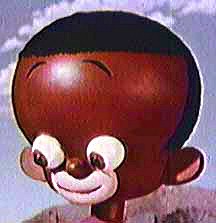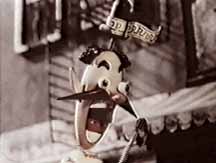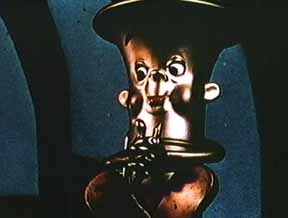
The puppetoon shorts of George Pal






Pal arguably pioneered (some claim that a man named John Sutherland was doing it at the same time) replacment animation, the technique in which multiple puppets (or multiple PARTS of puppets) were made to represent each action desired. For instance, rather than making a soft, malleable head for a character in order to be able to represent facial expressions and speech, the character would have numerous heads which, when animated in the proper sequence, could "speak" anything or show any emotion. This required a LOT of planning and sculpting of puppets prior to making a film, but once the puppets were done, they could be reused infinitely, and the films done this way have a unique fluidity which is quite beautiful and unique.
Información e imágenes tomadas de:George Pal's PUPPETOONS averaged eight minutes in length, requiring some 30,000 single frames (pictures) and 9,000 individually hand-carved wood figures for each frame of film. Their production was similar to that of a two-dimensional drawn cartoon. With his writers, Pal would come up with the story, and dialogue if any. The production would be storyboarded, sketched out shot by shot and decisions would be made about set designing and music. Pal would render color drawings of the main characters and their movements in each sequence, completing the first, middle, and last drawing of the animation. The artists employed as in-betweeners, filled in the character's movements between these three extremes. The drawings were then photographed to test the smoothness of the action. In a sense, a two-dimensional cartoon, in rough artist sketches was first made for every Puppetoon. Then while sets and props were being constructed in miniature, there were weeks of careful carving of the characters from wood.
To animate a wooden face it was necessary to produce twenty-four or more slightly different changes of expression for each second of action. The expressions were general enough, at times, to allow for the repeating of action, but speaking dialogue or singing an operatic aria allowed for a few short-cuts. The bodies of Pal's puppets were also made from wood and covered with cloth and costume. The limbs were constructed of multi-stranded wire which could be bent many times and into an unlimited number of positions. For upright support, wire pegs were placed in the puppet's feet and made to fit holes drilled in the floor of the set.
Finally, the single-frame photography was accomplished under the guidance of an exposure sheet based on a pre-recorded sound track. Editing, synchronization, and other post-production work completed the process. When in full operation, Pal was turning out one Puppetoon film every forty-five days. The cost of this in today's dollars would probably place each 8 minute short at the cost of several million dollars a piece compared to tens of thousands in the 1940's.
He aquí todos los cortometrajes que he logrado encontrar en el eMule de este genial director/animador de origen húngaro. La mayoría forman parte de la serie de "Jasper" (el personaje de la foto de abajo a la izquierda). Los cortos están en inglés, y hay muy pocas fuentes. Creo que ya se ha compartido por aquí alguna que otra cosa de Pal, así que confío en que surja interés para meter un poco de presión.
Estos son los he conseguido completar hasta ahora:
Estos los tengo a medias, pero me consta que hay fuentes completas (de hecho, algunas entre usuarios de DivXclasico, que llegaron después que yo y ya véis...):
Y finalmente, éste es el único sobre el que aún albergo dudas de que pueda estar completo. Pero no pierdo la esperanza:
Agradecería que los que estén interesados empiecen a pelearse con los archivos que tengo aún sin completar, para asegurarnos de que nos hacemos con todos. Por mi parte dejaré compartiendo los que vaya completando todo el tiempo que haga falta.
Un saludo.
